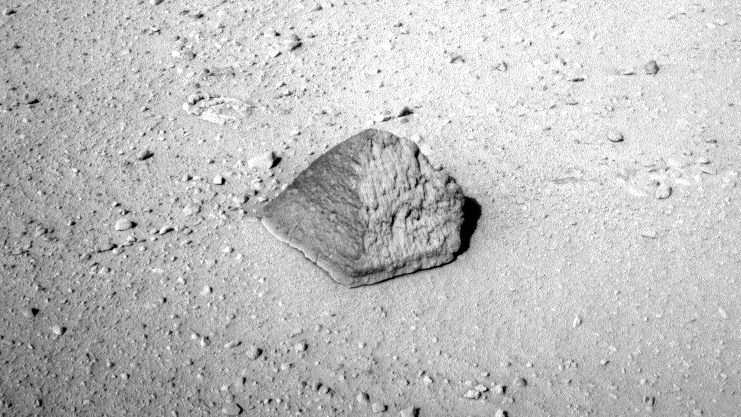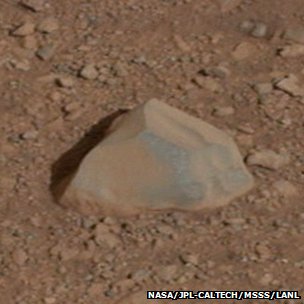It looks like you're using an Ad Blocker.
Please white-list or disable AboveTopSecret.com in your ad-blocking tool.
Thank you.
Some features of ATS will be disabled while you continue to use an ad-blocker.
share:

NASA's Mars Rover Curiosity has its first analysis target, an intriguing rock with a pyramidal shape that is now 8.2 feet (2.5 meter) from its current location. The scientists at the Jet Propulsion Laboratory are excited about this and other features discovered by the rover's cameras.
In fact, it seems that they have hit a jackpot, according to Mars Science Laboratory Project Scientist John Grotzinger, at Caltech:
As we're getting closer to the light-toned area, we see thin, dark bands of unknown origin. The smaller-scale diversity is becoming more evident as we get closer, providing more potential targets for investigation.
Thought some of you here would appreciate this story. Interesting find, but it really speaks to the advances and technology the rover is employing in this latest exploration of Mars. I really do hope they find signs of ancient life of any sort, hopefully soon
Enjoy
reply to post by SLAYER69
Nice find Slayer69 . When I view these rocks and others I try to keep in mind life on other planets may not be organic like of EA*RTH nor may it behave the same. I would like to ask are their any tracks showing it last location to where it is now. Unless there are miniature people there and the rover got in their way so they had to move it with advanced telekinesis..
Nice find Slayer69 . When I view these rocks and others I try to keep in mind life on other planets may not be organic like of EA*RTH nor may it behave the same. I would like to ask are their any tracks showing it last location to where it is now. Unless there are miniature people there and the rover got in their way so they had to move it with advanced telekinesis..
I love a title like that that's followed by the OP being
you, SLAYER.
So cool !
Ancient Civilizations and past life on Mars
are two of the coolest subjects with a bit
higher chance,than most, for pay off!
It gets more intriguing everyday.
you, SLAYER.
So cool !
Ancient Civilizations and past life on Mars
are two of the coolest subjects with a bit
higher chance,than most, for pay off!
It gets more intriguing everyday.
reply to post by Ophiuchus 13
www.abovetopsecret.com...
is rock has been posted about a few times.
www.abovetopsecret.com...
www.abovetopsecret.com...
is rock has been posted about a few times.
www.abovetopsecret.com...
edit on 20-9-2012 by ThePeopleParty because: (no reason given)
that's pretty cool. It is striated one direction on one side, and perpendicular on the other.
That's weird!
That's weird!
The first analysis. This is gonna be cool.
But I think the "unknown origin" seems to be out of context. I think that Grotzinger was referring to dark banding in the terrain.
www.jpl.nasa.gov...
But I think the "unknown origin" seems to be out of context. I think that Grotzinger was referring to dark banding in the terrain.
Three types of terrain intersect in the Glenelg area -- one lighter-toned and another more cratered than the terrain Curiosity currently is crossing. The light-toned area is of special interest because it retains daytime heat long into the night, suggesting an unusual composition.
"As we're getting closer to the light-toned area, we see thin, dark bands of unknown origin," said Mars Science Laboratory Project Scientist John Grotzinger of the California Institute of Technology, Pasadena. "The smaller-scale diversity is becoming more evident as we get closer, providing more potential targets for investigation."
www.jpl.nasa.gov...
reply to post by ThePeopleParty


which one moved the OP original or the second? Also any pics with tracks?


which one moved the OP original or the second? Also any pics with tracks?
edit on 9/20/12 by Ophiuchus 13 because: (no reason given)
Man! i can't wait for new things to see, i'm just fascinated by Mar's past environment. Hmmm! was is it a pre-earth or a post-earth!... click away
rover!
anyway...
i know this is kind of off topic, but i have been frustrated over on how to convert the small NASA raw images into bigger images. Can someone link me to a site or guide on conversions? - Thanks.
anyway...
i know this is kind of off topic, but i have been frustrated over on how to convert the small NASA raw images into bigger images. Can someone link me to a site or guide on conversions? - Thanks.
reply to post by SLAYER69
I've misread it at first, thinking the size of the rock is 8.2 feet, but...it moved that much
Reminds me of the mysterious moving rocks at death valley.
It wouldn't surprise me if they witness occasional soil icing there.
(Hmmm so, how big is this thing?)
I've misread it at first, thinking the size of the rock is 8.2 feet, but...it moved that much
Reminds me of the mysterious moving rocks at death valley.
It wouldn't surprise me if they witness occasional soil icing there.
(Hmmm so, how big is this thing?)
reply to post by SLAYER69
Yeah...we live in a crazy world...governments printing money as if they think its for free and such... Now 'they' fly all over to Mars, spending billions of those dollars just to fire a laser into a suspicious looking pyramid shaped rock....just to be sure it is a rock.
Yeah...we live in a crazy world...governments printing money as if they think its for free and such... Now 'they' fly all over to Mars, spending billions of those dollars just to fire a laser into a suspicious looking pyramid shaped rock....just to be sure it is a rock.
edit on 20/9/2012 by zatara because: (no reason given)
Originally posted by SLAYER69
Mars Rover to Study Pyramid Rock of Unknown Origin
NASA's Mars Rover Curiosity has its first analysis target, an intriguing rock with a pyramidal shape that is now 8.2 feet (2.5 meter) from its current location. The scientists at the Jet Propulsion Laboratory are excited about this and other features discovered by the rover's cameras.
In fact, it seems that they have hit a jackpot, according to Mars Science Laboratory Project Scientist John Grotzinger, at Caltech:
As we're getting closer to the light-toned area, we see thin, dark bands of unknown origin. The smaller-scale diversity is becoming more evident as we get closer, providing more potential targets for investigation.
Thought some of you here would appreciate this story. Interesting find, but it really speaks to the advances and technology the rover is employing in this latest exploration of Mars. I really do hope they find signs of ancient life of any sort, hopefully soon
Enjoy
It reminds me of a benben stone ... like the one used to cap the top of the pyramids in Egypt but more weathered.

Woody
reply to post by SLAYER69
That's really cool, I'm quite excited to see what they discover with this new rover.
I doubt that they'd tell us if they found any evidence of civilization however. Past life forms of some kind? Sure.
But the juicy stuff would most likely end up classified.
~Tenth
That's really cool, I'm quite excited to see what they discover with this new rover.
I doubt that they'd tell us if they found any evidence of civilization however. Past life forms of some kind? Sure.
But the juicy stuff would most likely end up classified.
~Tenth
I'm just waiting for Curiosity to mozy on up to the tubes :^)
I think it would be cool when they zap it with the laser you see little Egyptians running out of it.
Hoagland is probably already blowing up the phone lines at the Coast2Coast studio, reminding everyone what a genius he is and insisting that he
actually discovered this rock in 1989.
Originally posted by gravitational
reply to post by SLAYER69
I've misread it at first, thinking the size of the rock is 8.2 feet, but...it moved that much
Reminds me of the mysterious moving rocks at death valley.
It wouldn't surprise me if they witness occasional soil icing there.
(Hmmm so, how big is this thing?)
the rock didn't move. reread that sentence. it's saying the rover is that far away from the rock.
reply to post by SLAYER69
i cant see the other two sides but if we assume the other sides are similar , for this rock to take shape naturlly it would need winds or water flowing over it on all sides equally with equal succseesion or a combination of wind and water to make a pyramid shape.
i cant see the other two sides but if we assume the other sides are similar , for this rock to take shape naturlly it would need winds or water flowing over it on all sides equally with equal succseesion or a combination of wind and water to make a pyramid shape.
edit on 21-9-2012 by
DocHolidaze because: (no reason given)
Oh Good lord....
They are going to run over hundreds, maybe thousands of little Martians that live around the largest structure they ever created.
Good work NASA.... siiiighh
Lets just hope the other little Martians 30 Meters away from the Martians that they once built this Pyramid for don't think the rover is some gigantic robot weapon and fire off a few tiny nukes at it.
They are going to run over hundreds, maybe thousands of little Martians that live around the largest structure they ever created.
Good work NASA.... siiiighh
Lets just hope the other little Martians 30 Meters away from the Martians that they once built this Pyramid for don't think the rover is some gigantic robot weapon and fire off a few tiny nukes at it.
why havent we found out more about mars. Just curious are they hiding things
new topics
-
Simulation theory and have we reset before like a game?
Conspiracies in Religions: 3 hours ago -
Imagine how it feels
US Political Madness: 4 hours ago -
Do I post here or Cryptozoology.
Ancient & Lost Civilizations: 5 hours ago -
Breakthrough treatment flips cancer cells back into normal cells
General Chit Chat: 5 hours ago -
New World Order Coming?
New World Order: 6 hours ago
top topics
-
Breakthrough treatment flips cancer cells back into normal cells
General Chit Chat: 5 hours ago, 9 flags -
Imagine how it feels
US Political Madness: 4 hours ago, 7 flags -
Short vs. Long?
General Chit Chat: 14 hours ago, 5 flags -
Do I post here or Cryptozoology.
Ancient & Lost Civilizations: 5 hours ago, 5 flags -
New World Order Coming?
New World Order: 6 hours ago, 4 flags -
Simulation theory and have we reset before like a game?
Conspiracies in Religions: 3 hours ago, 4 flags
active topics
-
Imagine how it feels
US Political Madness • 16 • : rickymouse -
New World Order Coming?
New World Order • 20 • : soulrevival -
-@TH3WH17ERABB17- -Q- ---TIME TO SHOW THE WORLD--- -Part- --44--
Dissecting Disinformation • 3856 • : xuenchen -
Spy Music
Music • 49 • : Hellmutt -
Treasury Secretary Janet Yellen Says The USA Will Be in Debt Default in Jan 2025 - Unless...
Mainstream News • 39 • : cherokeetroy -
Elon Musk futurist?
Dreams & Predictions • 24 • : fringeofthefringe -
2 Guys die hunting Bigfoot
Cryptozoology • 21 • : BeyondKnowledge3 -
Outgoing Lame Duck BIDEN Officials and Democrats Voice Their Regrets.
2024 Elections • 22 • : xuenchen -
Simulation theory and have we reset before like a game?
Conspiracies in Religions • 5 • : G1111B1234 -
President Carter has passed
Mainstream News • 23 • : andy06shake
